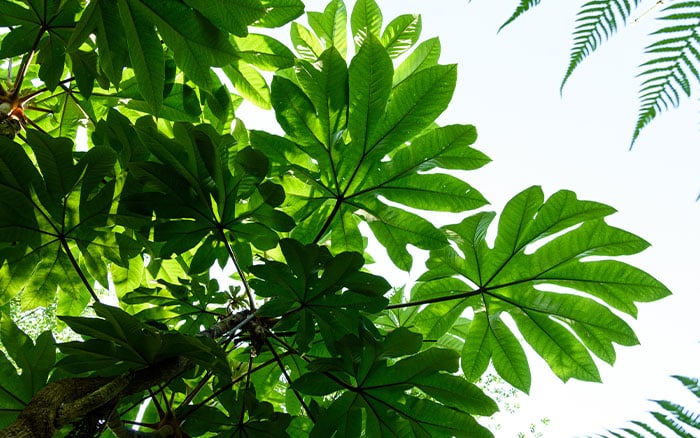While flowers often steal the show in garden design, foliage quietly builds the backbone of year-round structure and presence. Leaves add texture, contrast, and drama to planting schemes, and in many gardens they’re the real stars.
For instant impact, choose plants with bold foliage to anchor borders, frame delicate planting, and create that lush, mature feel.
Why bold foliage matters
Large or architectural leaves do more than grab attention; they shade soil, conserve moisture, and help suppress weeds. Their strong outlines bring balance and lift dull planting, especially when bold foliage contrasts with finer textures like grasses or ferns.
They also add a welcome scale in small gardens, where one dramatic specimen can make the whole space feel bigger.
Plant stars with statement leaves
Tropical jungle look
Tetrapanax papyrifer ‘Rex’ (Rice Paper Plant) has vast, lobed leaves for instant appeal and bold foliage drama; shelter improves hardiness.
Colocasia esculenta (Elephant’s Ear) offers heart-shaped leaves and summer theatre; lift for winter, as it isn’t reliably hardy in Britain.
Farfugium japonicum (Leopard Plant) thrives in shade, with glossy, rounded leaves and autumn daisies for late-season interest.
Cottage garden drama
Crambe cordifolia (Greater Sea Kale)pairs crinkled leaves with honey-scented white clouds, partnering beautifully with surrounding bold foliage.
Rheum ‘Ace of Hearts’ forms a striking mound of heart-shaped, architectural leaves that supply long-lasting structure.
Cynara cardunculus (Cardoon) delivers silvery, spiny leaves and tall purple flowers loved by bees, adding drama without heaviness.
Year-round evergreen
Fatsia japonicaprovides glossy, hand-shaped leaves; shade tolerant, hardy, and dependable for year-round bold foliage.
Bergenia (Elephant’s Ears) has leathery leaves that colour in winter, with spring flowers and reliable edging performance.
Dramatic but with caution
Gunnera manicata (Giant Rhubarb) makes a spectacular waterside statement with prehistoric leaves; avoid Gunnera tinctoria, banned in the UK as invasive. Existing clumps can usually remain, but don’t plant new stock unless provenance is certain.
Hosta ‘Empress Wu’ commands attention with corrugated blue-green leaves; protect against slugs to keep specimens immaculate.
Top tips for planting
- Shelter from wind – large leaves like those of Tetrapanax ‘Rex’or Colocasia can shred easily. Give them a sheltered spot.
- Moisture matters – big leaves lose more water. Keep soil rich in organic matter and mulch well to lock in moisture.
- Feed generously – bold foliage can often need regular feeding depending on the soil type and condition. Apply a high nitrogen, slow-release fertiliser in spring. Top up with liquid feeds during the summer months.
- Think about scale – one giant plant can dominate. Balance it with contrasting textures or repeat plantings to create a cohesive planting scheme.
- Winter protection – many bold-leaved stars are borderline hardy. Fleece crowns, mulch roots, or move container-grown plants under cover.
A garden with presence
Plants with bold foliage do more than fill gaps; they create atmosphere.
Whether your goal is a cool, shady retreat, a jungle-esque hideaway, or simply adding structure to a border, these leafy giants are perfect. Add just one, and you’ll soon see how much presence a bold leaf plant can bring!
For more great gardening advice, make sure you head to my YouTube Channel. Make sure you’re subscribed with notifications on so you don’t miss any of my new videos
Frequently Asked Questions
1) What is “bold foliage,” and why use it?
Bold foliage means large, architectural leaves that add instant impact. They anchor borders, create balance, and contrast beautifully with finer textures like grasses or ferns.
2) Which bold-foliage plants work in small gardens?
Choose one statement specimen, such as Fatsia japonica or Rheum ‘Ace of Hearts’. A single focal plant can make compact spaces feel larger and more confident.
3) Where should I position bold-foliage plants?
Shelter them from strong winds to prevent leaf shredding. Most prefer rich soil, consistent moisture, and some protection from midday sun.
4) Do bold-foliage plants need extra feeding and watering?
Yes. Big leaves transpire more, so mulch to retain moisture. Use a high-nitrogen, slow-release feed in spring, then top up with summer liquid feeds.
5) Are there cautions with dramatic giants like Gunnera?
Gunnera manicata suits large, damp sites but needs winter protection. Avoid Gunnera tinctoria, which is banned in the UK for invasive behaviour.



Leave A Comment